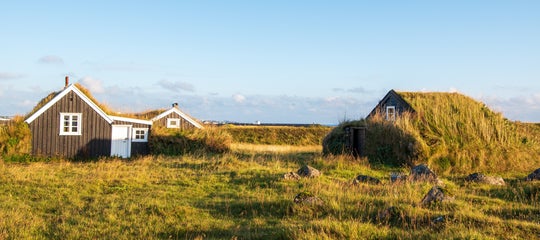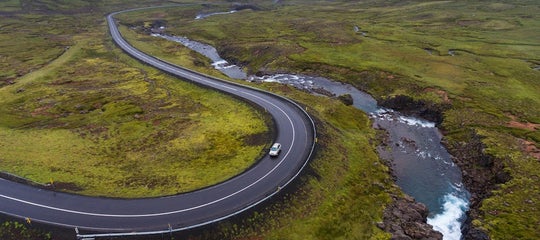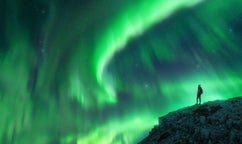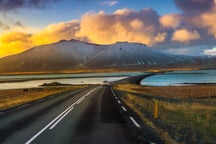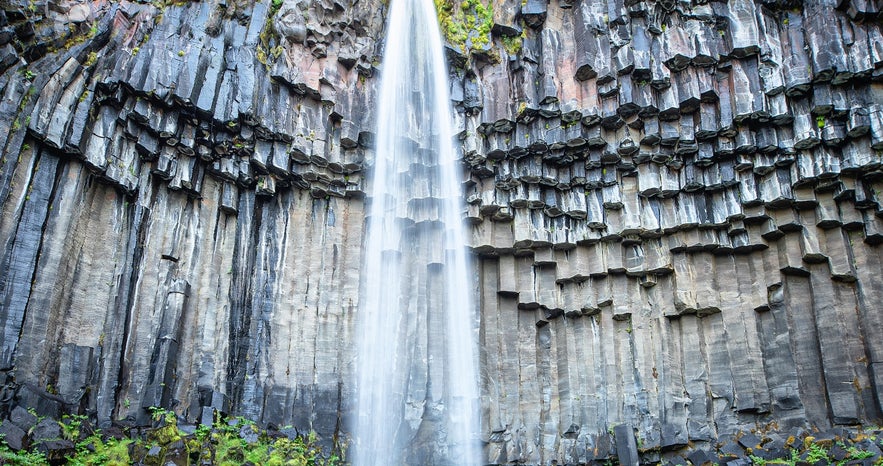
Basalt columns are one of Iceland's most fascinating natural phenomena. These hexagonal rock formations, sculpted by environmental forces, take various forms and create astonishing landscapes. Discover where to see the most spectacular basalt columns in Iceland and why they belong on every traveler's itinerary.
Basalt columns can be found all over Iceland in various forms. Whether nestled in Icelandic national parks or rising above the country’s iconic black sand beaches, basalt columns are an incredible sight and a signature of Iceland’s unique landscape.
Why You Can Trust Our Content
Guide to Iceland is the most trusted travel platform in Iceland, helping millions of visitors each year. All our content is written and reviewed by local experts who are deeply familiar with Iceland. You can count on us for accurate, up-to-date, and trustworthy travel advice.
To fully experience these wonders, many travelers choose to rent a car, allowing the flexibility to explore hidden gems and lesser-known locations at their own pace. Alternatively, several popular tours in Iceland include visits to the most impressive basalt column sites, often alongside waterfalls, glaciers, and geothermal hotspots.
In this article, we'll explore how basalt columns come to be, where you can find them in Iceland, and why they continue to enchant visitors and locals alike. Join us as we unravel the mystery and charm of Iceland's basalt columns.
Key Takeaways
-
A Range of Rocks: No two basalt columns are exactly alike. They form in a variety of shapes and appear in different settings, from framing waterfalls to standing alone in national parks.
-
Do Not Disturb: Basalt columns are protected. Visitors should avoid walking on them or taking pieces of rock.
-
Folkloric Significance: Their strange, otherworldly shapes have inspired Icelandic folklore for centuries. Many are linked to stories of trolls, giants, and hidden people.
How Are Basalt Columns Formed?
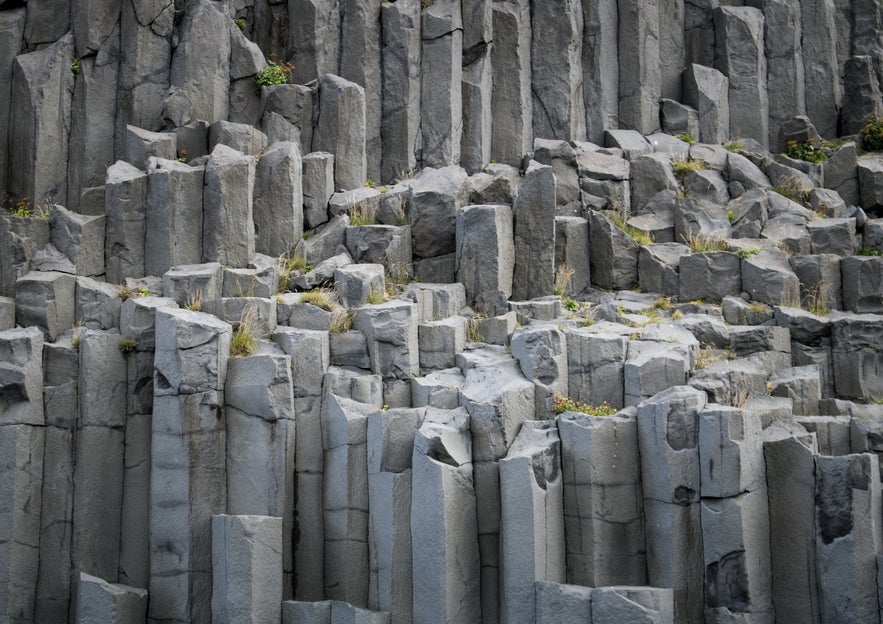
Basalt columns are created by the cooling and solidification of basalt lava, the molten rock expelled by volcanoes when they erupt. Basalt is a common type of volcanic rock rich in iron and magnesium and low in silica. It's characterized by a dark color, typically gray to black, and a fine-grained texture.
Basaltic eruptions make up most of Iceland's geological activity because the country sits atop the Mid-Atlantic Ridge, where the Eurasian and North American tectonic plates diverge. This setting provides a constant source of magma from the Earth's mantle, much of which is basaltic in composition.
Basalt columns commonly appear as long, vertical, and hexagonal pillars ranging from a few feet to several meters in height. When clustered together, they create an imposing and geometrically intricate landscape.
The hexagonal shape of these columns is a natural response to the stress of contraction. As lava contracts, it forms shapes that reduce stress, and hexagons are the most efficient way to alleviate pressure while maintaining a consistent shape and minimizing surface area.
Basalt Column Locations in Iceland

Once you've seen one basalt column, you've seen them all, right? Not even close! Because of the prevalence of basalt rock and volcanic activity in the country, you can find basalt columns all over Iceland, and each of them is unique. Whether they’re framing a magnificent waterfall or adorning the cliffs of a stunning canyon, no two formations are the same.
Here are some of the best locations to visit Iceland’s basalt columns.
Reynisfjara Black Sand Beach
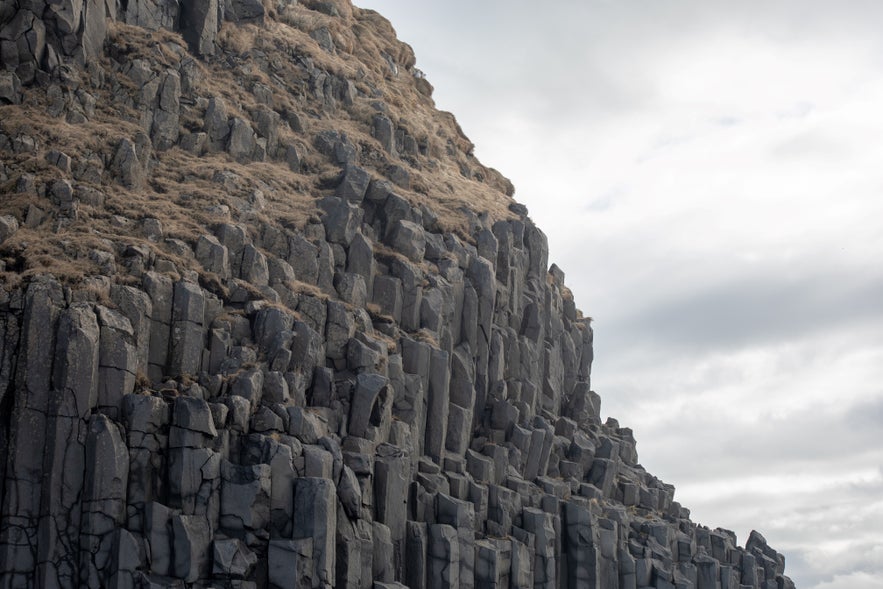
At Reynisfjara, these basalt formations rise majestically alongside the beach, showcasing the powerful interaction of elemental forces. The dramatic contrast of the dark stone pillars against the backdrop of rolling waves and black sand is a sight to behold.
Atop the cliffs, visitors may spot one of Iceland's cutest residents—the puffin. This sea bird makes its home there.
 While Reynisfjara is an attraction that should not be missed, visitors are advised to exercise caution. Wave conditions can be potentially dangerous, so swimming is prohibited. And please respect the natural environment by not climbing the columns or disturbing any wildlife nests.
While Reynisfjara is an attraction that should not be missed, visitors are advised to exercise caution. Wave conditions can be potentially dangerous, so swimming is prohibited. And please respect the natural environment by not climbing the columns or disturbing any wildlife nests.
Studlagil Canyon

Located in the eastern part of the country, Studlagil Canyon is one of Iceland's lesser-known gems. The walls of the canyon are adorned by basalt rock formations, and a crisp glacial river fed by meltwater flows through it. This water carries fine sediment and minerals, making it appear as though its color is constantly changing.
- See also: Top 11 Amazing Canyons in Iceland
Svartifoss Waterfall
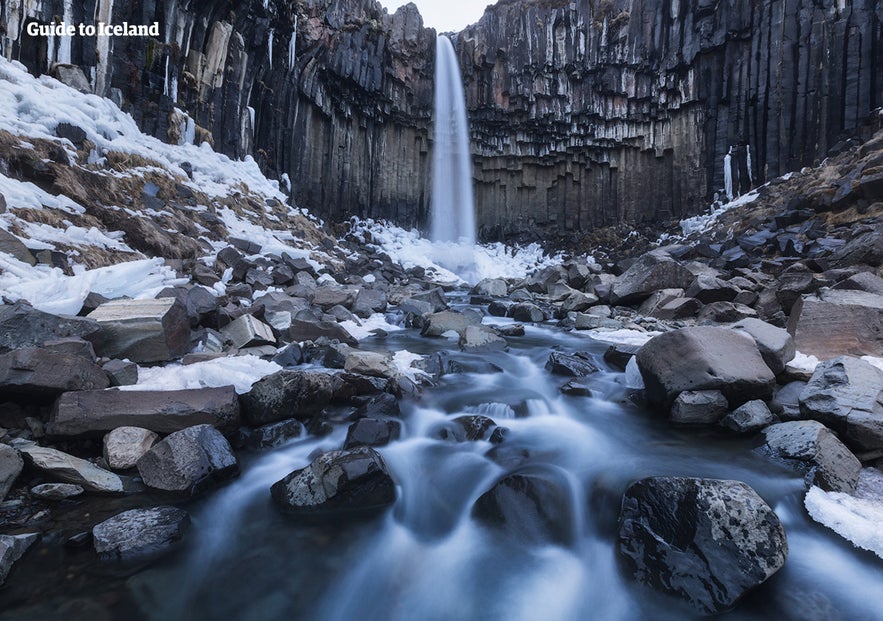
Svartifoss Waterfall, located in Skaftafell Nature Reserve in Vatnajokull National Park, is particularly famous for its dramatic backdrop of dark basalt columns. These formations inspired its name, which translates to "Black Falls."
Approaching Svartifoss Waterfall is like entering a cathedral, with the hexagonal columns encircling the falls reminiscent of the pipes of an organ. The falls are accessible via a moderate hike, which offers gorgeous views of the area's rich flora, glacial ice, and rugged landscape.
Hljodaklettar
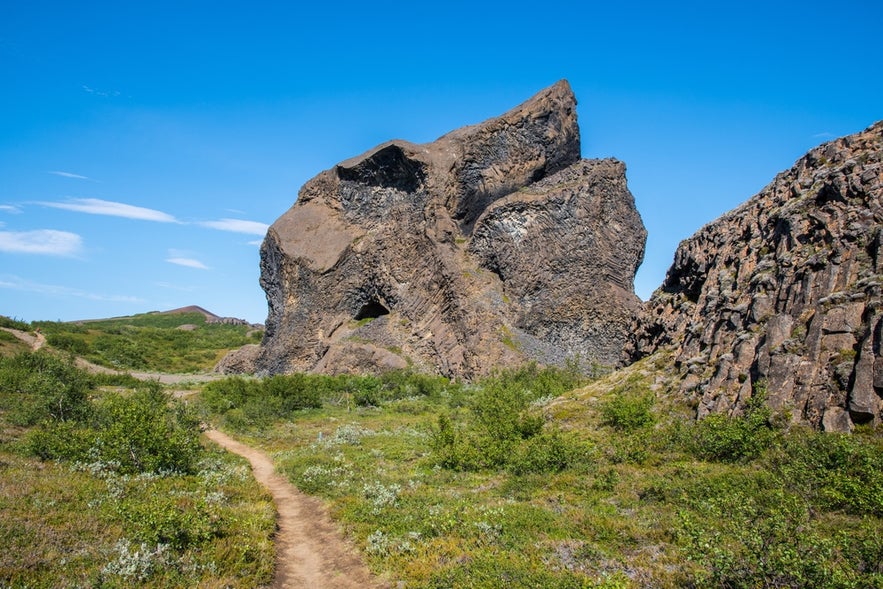 Also in Vatnajokull National Park, Hljodaklettar is known as “Echo Rocks,” because of the sounds created by the formations in the area. On this circular trail, you’ll see Kastili, which is shaped like a castle; Trollid, so-named because of the legend that rock formations are trolls turned to stone in the sunlight; and Kirkjan, which is perfectly arch-shaped.
Also in Vatnajokull National Park, Hljodaklettar is known as “Echo Rocks,” because of the sounds created by the formations in the area. On this circular trail, you’ll see Kastili, which is shaped like a castle; Trollid, so-named because of the legend that rock formations are trolls turned to stone in the sunlight; and Kirkjan, which is perfectly arch-shaped.
Kirkjugolf Stones
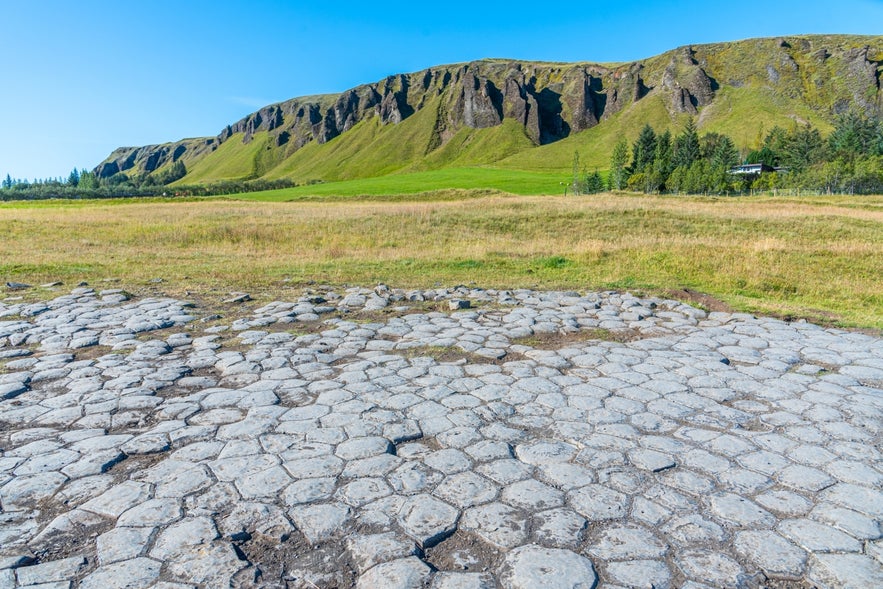
Kirkjugolf, or the "Church Floor," is a natural wonder located in South Iceland, near the town of Kirkjubaejarklaustur. It’s composed of a well-preserved natural basalt column pavement, which resembles a man-made floor, thus inspiring its name.
While Kirkjugolf may look like the remnants of an ancient settlement, the “Church Floor” was actually formed by an expanse of basalt stone slabs that slowly eroded as the sea covered the area. In fact, there has never been a settlement in the area. The surprisingly intricate formation is surrounded by grassy fields, distinguishing it in the landscape.
Dverghamrar Cliffs
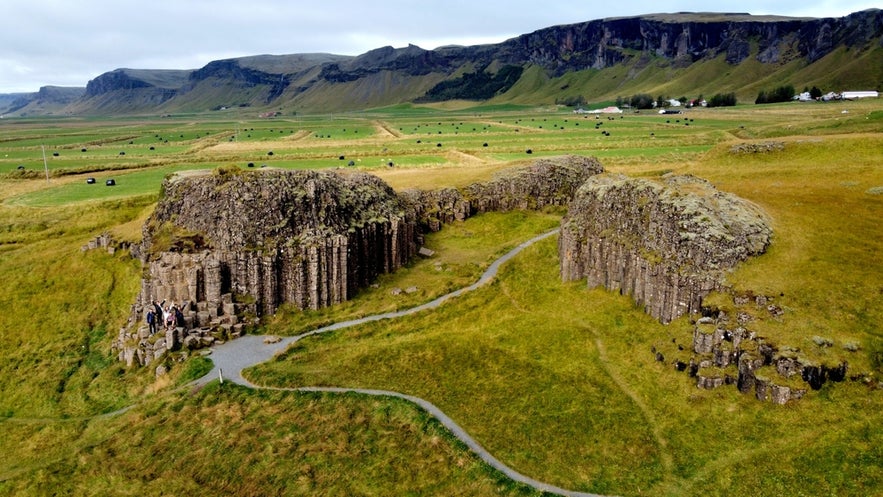 Located near Kirkjugolf is Dverghamrar, often referred to as the "Dwarf Cliffs." This basalt column formation takes the shape of a small canyon. The cliffs figure heavily into Icelandic folklore, with local legends suggesting that dwarves and elves inhabit the area.
Located near Kirkjugolf is Dverghamrar, often referred to as the "Dwarf Cliffs." This basalt column formation takes the shape of a small canyon. The cliffs figure heavily into Icelandic folklore, with local legends suggesting that dwarves and elves inhabit the area.
Many people claim to have heard singing or music coming from the rocks, but unfortunately, the elves have not released a performance schedule just yet.
Dverghamrar is less crowded than many of the other attractions on this list, making it easy to park your car, stroll around the area, and possibly spot a mythological creature or two.
Aldeyjarfoss Waterfall
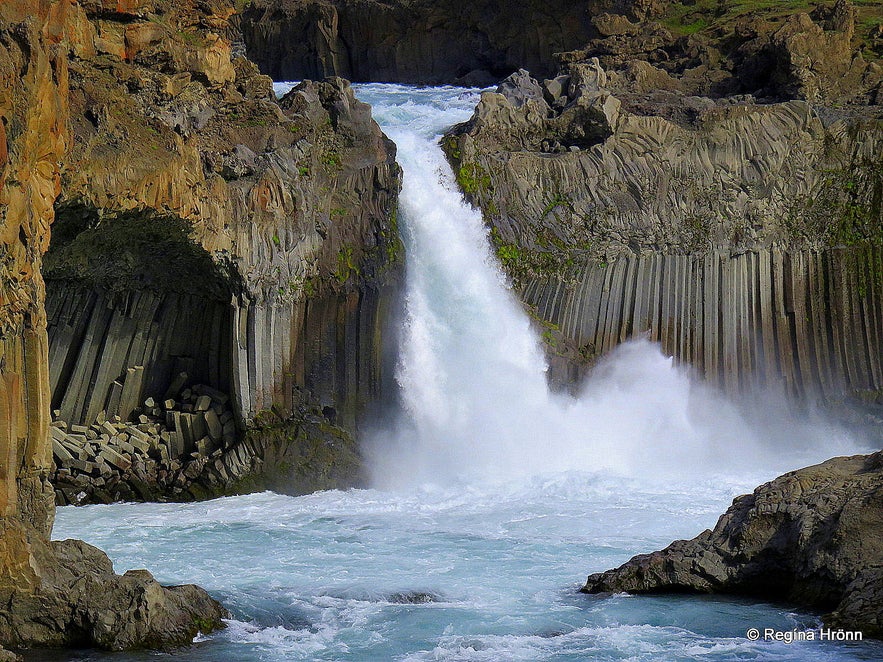
The majestic Aldeyjarfoss Waterfall, nestled in the Highlands, is flanked by basalt column walls that lend a gothic-like beauty. The rock formations in this area take on many colors, ranging from black to hues of yellow and orange. The waterfall's isolated location contributes to its untouched beauty.
Litlanesfoss Waterfall

Litlanesfoss Waterfall in East Iceland is encased by towering basalt cliffs that are among the tallest in the country. It's positioned along the Hengifoss River, with the water flowing from the surrounding moorland and cascading elegantly down the rugged basaltic terrain.
The waterfall is surrounded by lush vegetation, which starkly contrasts with the dark rock formations. Many other natural pearls are nearby, such as Hengifoss Waterfall, which runs from the same river.
Gerduberg
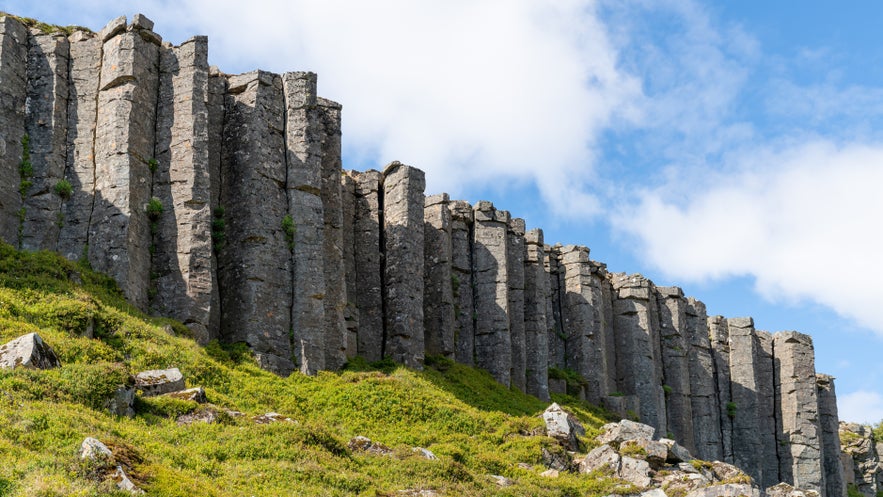
Gerduberg is a series of symmetrical basalt columns on the Snaefellsnes Peninsula. These pillars reach up to 46 feet (14 meters) tall and form a massive wall-like structure resembling a fortress.
The columns are spread out across the area, with an old path running alongside them. Gerduberg is one of the first things you'll see when visiting Snaefellsnes from Reykjavik, making it a great photo stop and place to go for a walk.
Studlafoss Waterfall
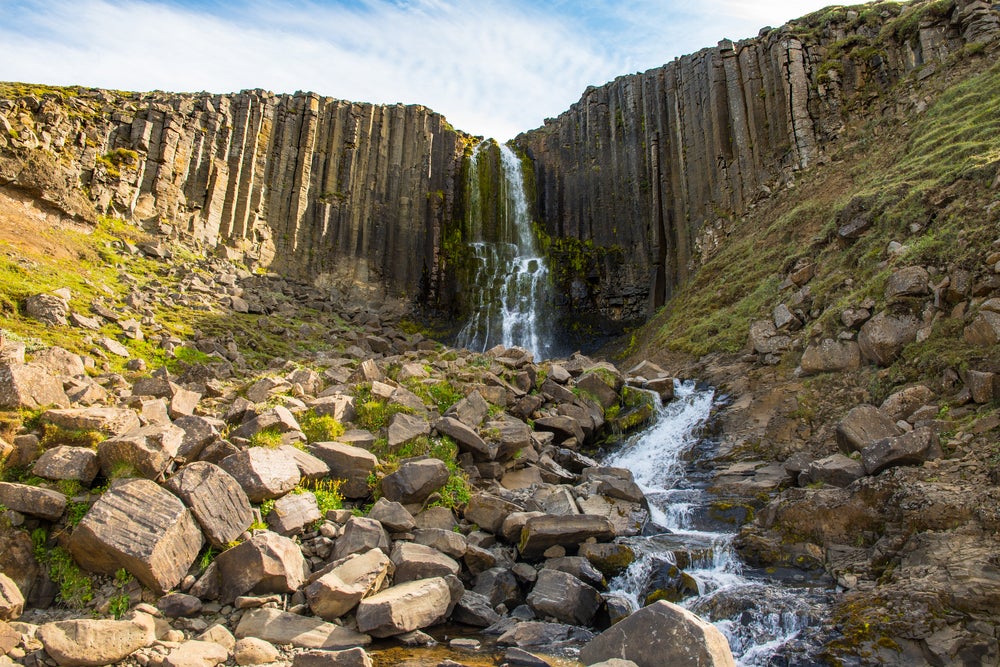 If your Iceland travels take you to the Eastfjords, be sure to visit Studlafoss Waterfall—another cascade of water framed by imposing basalt column formations. Avid hikers should be advised that it marks the entrance to a remote hiking trail, making it a great spot to start an invigorating day.
If your Iceland travels take you to the Eastfjords, be sure to visit Studlafoss Waterfall—another cascade of water framed by imposing basalt column formations. Avid hikers should be advised that it marks the entrance to a remote hiking trail, making it a great spot to start an invigorating day.
Kalfshamarsvik
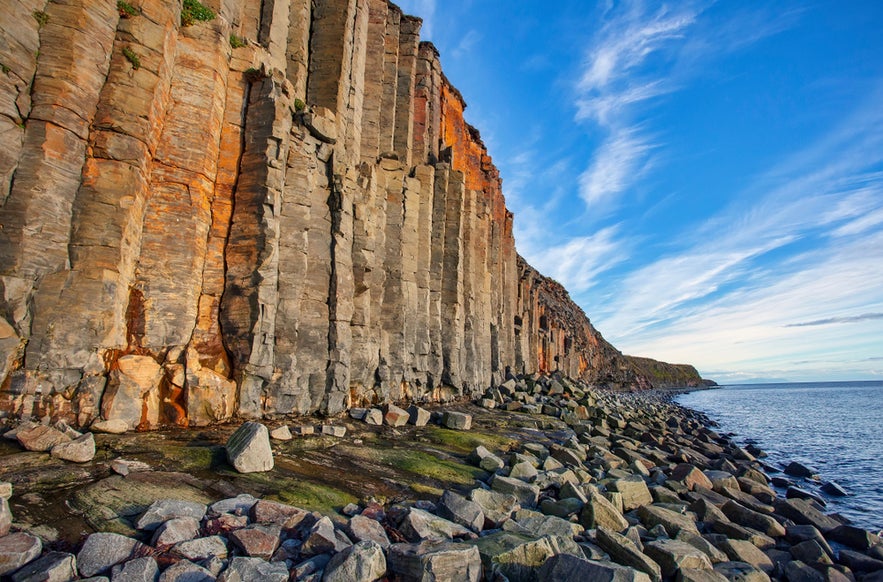 Lying on the very tip of the Skagi Peninsula in North Iceland, Kalfshamarsvik is a remote cove visitors can explore. The beach itself is made of large pebbles, and it’s surrounded by basalt columns. The area also boasts historic features, such as the ruins of an abandoned hamlet and an old lighthouse.
Lying on the very tip of the Skagi Peninsula in North Iceland, Kalfshamarsvik is a remote cove visitors can explore. The beach itself is made of large pebbles, and it’s surrounded by basalt columns. The area also boasts historic features, such as the ruins of an abandoned hamlet and an old lighthouse.
Arnarstapi to Hellnar Hike
 The 2.1-mile (3.8-kilometer) east hiking trail from the village of Arnarstapi to the village of Hellnar on the Snaefellsnes Peninsula takes you around the shoreline, offering views of the ocean and several unique basalt rock formations. You’ll also spot lava cliff formations and hopefully a variety of wildlife, including sea birds.
The 2.1-mile (3.8-kilometer) east hiking trail from the village of Arnarstapi to the village of Hellnar on the Snaefellsnes Peninsula takes you around the shoreline, offering views of the ocean and several unique basalt rock formations. You’ll also spot lava cliff formations and hopefully a variety of wildlife, including sea birds.
How To Get to Basalt Columns in Iceland
 Since basalt columns are dotted all over Iceland, you’d be hard-pressed to find a tour that doesn’t take you to at least one formation. We’ve picked out some of the best itineraries for seeing them here.
Since basalt columns are dotted all over Iceland, you’d be hard-pressed to find a tour that doesn’t take you to at least one formation. We’ve picked out some of the best itineraries for seeing them here.
Self-Drive Tours
Self-drive tours combine expert itinerary planning with the freedom to go at your own pace and set your own schedule.
-
1-Week West and South Iceland Self-Drive Tour: A summer self-drive tour that takes you along the southern coastline, with plenty of opportunities for photographing volcanic rock cliffs.
-
10-Day Ring Road Self-Drive Tour: This self-drive tour along the Ring Road gives you the freedom to visit some of the most impressive basalt formations Iceland has to offer.
-
12-Day Ring Road and National Parks Self-Drive Tour: A longer summer self-drive tour includes time to wander around Iceland’s three national parks.
Guided Multi-Day Tours
Take advantage of the experience and knowledge of expert guides with guided multi-day tours that whisk you away to a variety of sights.
-
2-Day Northern Lights Tour of the Snaefellsnes Peninsula: This jam-packed guided tour of Snaefellsnes will take you to black sand beaches and towering coastal cliffs.
-
8-Day Guided Ring Road Tour: Travel around the Ring Road with an expert guide with plenty of opportunities to add on activities from horseback riding to ice caving.
-
11-Day Winter Ring Road Tour: This guided minibus tour pairs Iceland’s most popular destinations with hidden gems that only locals know.
Vacation Packages
Leave all the planning to experts with vacation packages that include accommodations, activities, transportation, and local guides.
-
5-Day Summer Vacation Package: This summer journey includes plenty of opportunities to take in the geological wonders of the Icelandic coastline.
-
Customizable 7-Day Icelandic Wonders Package: Personalization is the name of the game with this vacation package, which allows you to choose the activities that most interest you.
-
11-Day Ring Road Summer Vacation Package: This comprehensive tour around the Ring Road offers glacier hikes, whale-watching, and hot spring bathing.
Day Tours
Guided day tours are perfect for travelers with limited time or those looking for an exciting way to fill a few hours.
-
South Coast Waterfalls & Black Sand Beach Day Trip: This day-long, small-group sightseeing tour includes a stop to see the black sands and basalt structures of Reynisfjara.
-
5-Hour Highlands Helicopter Tour: See Reynisfjara and more South Coast formations from the skies and the ground on this helicopter tour of the Highlands, which includes multiple touch-down stops.
-
Studlagil Canyon and the Vok Baths Summer Tour From Egilsstadir: Discover East Iceland’s natural treasures on this full-day tour, including sightseeing at Studlagil Canyon and hot spring bathing at the Vok Baths.
-
Speedboat Puffin-Spotting Tour: Scope out the sea and the rocky cliffs of the coastline for the adorable puffin on this one-hour tour of the Eastfjords.
-
Snaefellsnes Peninsula Tour: This 11-hour minibus tour includes a walk along the coastline to wonder at the rock formations near Arnarstapi and Hellnar.
Icelandic Architecture Inspired By Basalt Columns
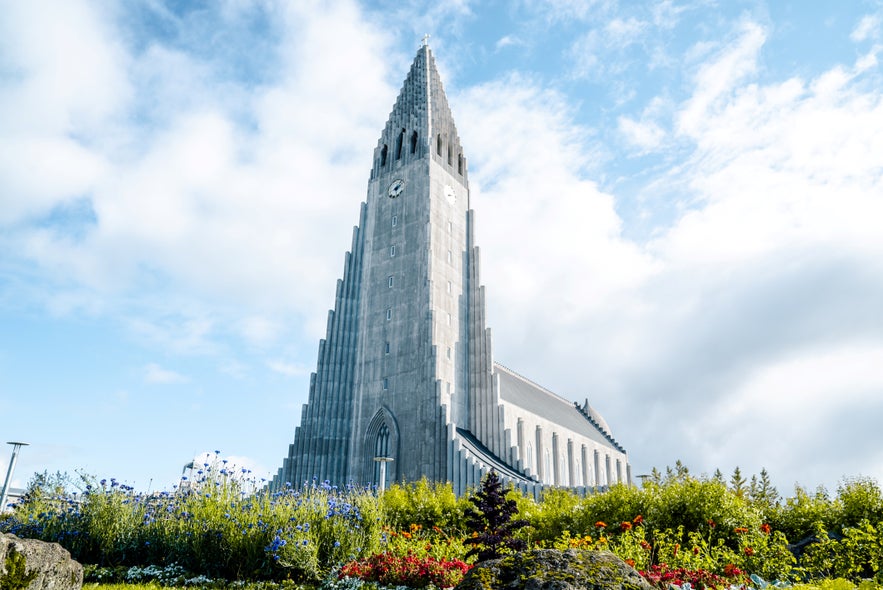
Many buildings and structures in Iceland incorporate design elements that echo the hexagonal shapes and symmetrical patterns of naturally occurring basalt columns. One of the country’s most prominent architects, Guðjón Samúelsson, is renowned for integrating elements of the country's geological landscape into his designs.
The most famous example of his signature work is the Hallgrimskirkja Church in Reykjavik. The church's iconic facade is characterized by tall, column-like structures that mimic the hexagonal shapes of the rock formations found across the country.
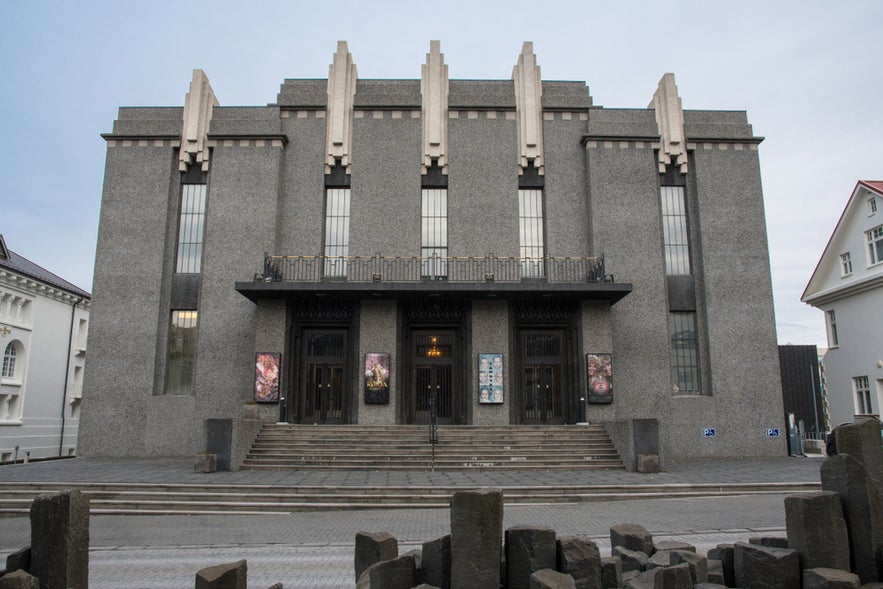 Another example of basalt columns inspiring Samúelsson is Iceland's National Theater, located in the center of Reykjavik. The building, which was built between 1928 and 1950, is adorned with shapes that mimic the lava rock features, giving the theater an imposing, neo-Gothic atmosphere.
Another example of basalt columns inspiring Samúelsson is Iceland's National Theater, located in the center of Reykjavik. The building, which was built between 1928 and 1950, is adorned with shapes that mimic the lava rock features, giving the theater an imposing, neo-Gothic atmosphere.

Other architects incorporated natural elements into their designs as well. Take the glass facade of the Harpa Concert Hall, designed by artist Olafur Eliasson. He created a dynamic interplay between the structure and its environment with geometric shapes that reflect the light and surrounding landscapes.
Map of Basalt Columns in Iceland
If you want to find the aforementioned basalt column locations, here's a handy map to help you navigate between them.
FAQs About Basalt Columns
Do you still have questions about this natural geological phenomenon? Keep reading to learn more.
1. Are basalt columns unique to Iceland?
No, basalt columns can be found elsewhere, such as at the Giant’s Causeway in Northern Ireland and Devils Postpile in California, USA. However, Iceland is renowned for its concentration and accessibility of these formations.
2. Can I climb on the basalt columns?
Yes, you can climb some basalt columns, but it depends on the location and how you define "climb." Casual scrambling for a photo is usually fine in certain places, but actual rock climbing is a different story.
Here’s how it breaks down for popular spots:
-
Reynisfjara Black Sand Beach: Visitors often climb the lower columns for pictures. This is tolerated, but caution is essential. The area is slippery, and dangerous waves are a serious hazard. Respect signage and stay alert.
-
Svartifoss Waterfall: Located in Vatnajokull National Park, this area is protected. Visitors can walk close to the waterfall, but climbing the columns is discouraged to preserve the landscape.
-
Studlagil Canyon: On the east side, you can walk near the basalt columns, and light scrambling is common. Climbing higher is not recommended as the area lacks safety measures and can be unstable.
3. How old are the basalt columns in Iceland?
Most of the basalt columns in Iceland are thousands of years old, dating back to volcanic activity from different geological periods.
4. Is it safe to visit basalt column sites year-round?
Some sites are accessible year-round, but others may have restricted access in winter due to snow or river levels. Always check local conditions before traveling.
5. Are the basalt columns protected?
Yes, many of these natural formations are protected due to their geological significance and fragility. Tourists are encouraged to respect the natural environment and stay on marked paths.
6. Can I take basalt rocks as souvenirs?
No, removing rocks or other natural elements from protected sites is illegal in Iceland. Visitors are encouraged to enjoy and photograph the formations without disturbing them.
Exploring Iceland’s Stone Pillars
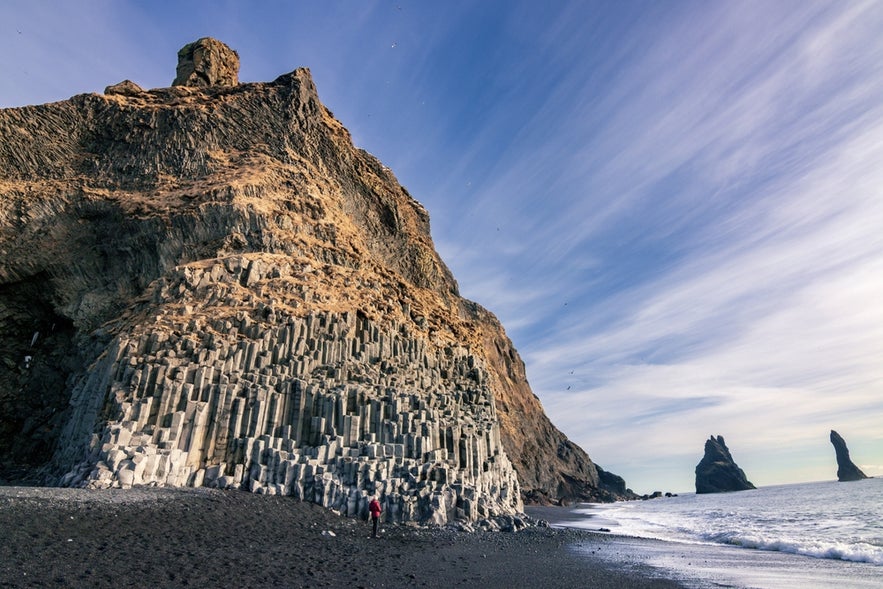 Wherever you travel in Iceland, from the North to the South Coast or from the West to the Eastfjords, you’re never far from a basalt rock formation. Take advantage of our list to seek out some that lie beyond the beaten path. Dating back thousands of years, these striking formations are lasting evidence of Iceland's volcanic history.
Wherever you travel in Iceland, from the North to the South Coast or from the West to the Eastfjords, you’re never far from a basalt rock formation. Take advantage of our list to seek out some that lie beyond the beaten path. Dating back thousands of years, these striking formations are lasting evidence of Iceland's volcanic history.
Did we miss any of your favorite basalt columns in Iceland? Which one would you most like to visit? Let us know in the comments below.


